
Nerstrand is a city in Rice County, Minnesota, United States.

Thorstein Bunde Veblen was an American economist and sociologist who, during his lifetime, emerged as a well-known critic of capitalism.

The John Scott Farm is a historic farmstead near the community of Shandon, Ohio, United States. Established in the nineteenth century and still in operation in the twenty-first, the farmstead has been named a historic site because of its traditionally built agricultural structures.
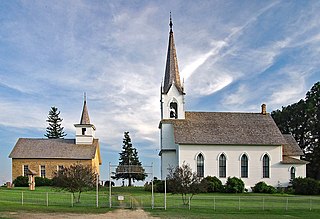
Valley Grove is a historic Lutheran church complex in Wheeling Township, Minnesota, United States. It consists of two 19th-century churches surrounded by a hilltop cemetery. The older building was constructed in stone in 1862 by a rural community of Norwegian immigrants. The congregation outgrew the first church and constructed a larger, wooden replacement in 1894, converting the original building into a guild hall. The property was listed on the National Register of Historic Places in 1982 for its local significance in the themes of architecture, art, and religion. It was nominated for encapsulating two phases of rural ecclesiastical architecture in a dramatic hilltop tableau, and for its role in anchoring eastern Rice County's dispersed community of Norwegian immigrants.

This is a list of the National Register of Historic Places listings in Rice County, Minnesota. It is intended to be a complete list of the properties and districts on the National Register of Historic Places in Rice County, Minnesota, United States. The locations of National Register properties and districts for which the latitude and longitude coordinates are included below, may be seen in an online map.

The Curtis—Shipley Farmstead is a historic home located at Ellicott City, Howard County, Maryland, United States. It is located on the first land grant in modern Howard County, then Anne Arundel County, to the English settler Adam Shipley in 1688 who settled properties in Maryland as early as 1675. The 500-acre estate was called "Adam the First".
Slack Farmstead is a historic farm complex and national historic district located at Mexico in Oswego County, New York. The district includes four contributing structures; the farmhouse, a dairy barn (1870), granary and a hen house. Also on the property are a contributing stone wall, hand-dug well, and farm pond. The farmhouse is a five-bay, 1+1⁄2-story frame building with a gable roof built about 1838.

Nerstrand City Hall is a historic city hall building in Nerstrand, Minnesota, United States, constructed in 1908. It was listed on the National Register of Historic Places (NRHP) on April 6, 1982, for having local significance in the theme of politics/government. It was nominated for being representative of Nerstrand's early growth, and for being Rice County's best example of municipal buildings of the early 20th century.
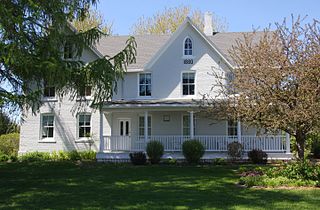
The Osmund Osmundson House is a historic house in Nerstrand, Minnesota, United States. The private home was placed on the National Register of Historic Places (NRHP) on April 6, 1982. The house is significant for its association with a prominent Rice County pioneer and town founder.

The Bonde Farmhouse is a historic farmhouse located in Wheeling Township in Rice County, Minnesota, United States, approximately 1 mile (1.6 km) from Nerstrand. The private home was placed on the National Register of Historic Places (NRHP) on April 6, 1982. The farmhouse is significant both for its association with a prominent Norwegian immigrant family as well as its local limestone construction and outstanding integrity.

Caspar Getman Farmstead is a historic home and related farm outbuildings located near Stone Arabia in Montgomery County, New York. It includes the main house and ell, two lateral-entry English barns, a New World Dutch barn, limestone smokehouse, and former chicken coop. The house has a two-story main block, five by five bay, with a center entrance, with an attached 1 1/2 story ell. It has a moderately pitched gable roof and is clad in clapboards.
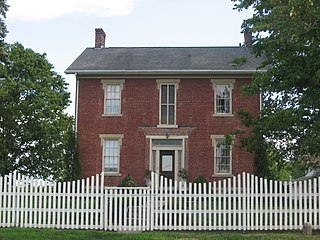
The William Baumgardner Farm is a historic farmstead located near New Carlisle in Miami County, Ohio, United States. Constructed in 1857, the site remains typical of period farmsteads, and it has been named a historic site.
The John and Katharine Tunkun Podjun Farm is a farm located at 9582 East 1 Mile Road in Ellsworth, Michigan. It was listed on the National Register of Historic Places in 2002.
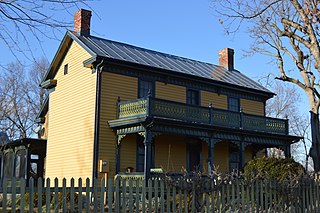
Bauserman Farm, also known as Kagey-Bauserman Farm, is a historic farmstead located near Mount Jackson, Shenandoah County, Virginia. The main house was built about 1860, and is a two-story, three-bay, gable-roofed, balloon-framed “I-house.” It has an integral rear ell, wide front porch and handsome late-Victorian scroll-sawn wood decoration. Also on the property are the contributing chicken house, a privy, a two-story summer kitchen, a frame granary, a large bank barn, a chicken house, the foundation of the former circular icehouse and the foundation of a former one-room log cabin.
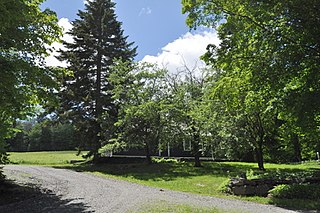
The Crows Nest is a historic farmstead property at 35 Sturgis Drive in Wilmington, Vermont. The 75-acre (30 ha) property includes rolling woods and a hay meadow, and a small cluster of farm outbuildings near the main house, a c. 1803 Cape style building. The property typifies early Vermont farmsteads, and is now protected by a preservation easement. It was listed on the National Register of Historic Places in 1998.

The Charles Spangenberg Farmstead is a historic farm in Woodbury, Minnesota, United States, established in 1869. The three oldest buildings, including an 1871 farmhouse, were listed together on the National Register of Historic Places in 1978 for having local significance in the theme of agriculture. The property was nominated for being one of Washington County's few remaining 19th-century farmsteads.

The David Hanaford Farmstead is a historic farm in Monticello Township, Minnesota, United States. It was first settled in 1855 and features a farmhouse built in 1870 and a barn from around the same time. The farmstead was listed on the National Register of Historic Places in 1979 for having local significance in the themes of agriculture and exploration/settlement. It was nominated for being "an excellent example of an early Wright County farmstead developed by a pioneer family from New England."
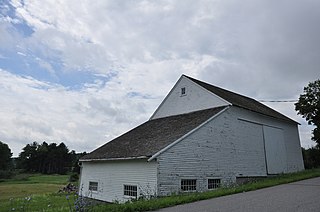
The Witherill Farm is a historic farm property on Witherill Road in Shoreham, Vermont. With a history dating to the late 18th century, the farm was for two centuries managed by generations of the same family, and was a noted early exporter of merino sheep to South Africa. Most of the farmstead buildings were built before 1850. The property was listed on the National Register of Historic Places in 1993.

The George Louk Farm is a rural farmstead located at 1885 Tooley Road near Howell, Michigan. It was listed on the National Register of Historic Places in 1995.



















